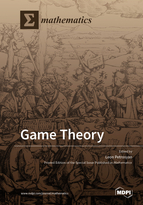Game Theory
A special issue of Mathematics (ISSN 2227-7390). This special issue belongs to the section "Mathematics and Computer Science".
Deadline for manuscript submissions: closed (31 May 2020) | Viewed by 35811
Special Issue Editor
Interests: theory of games; differential games; control theory
Special Issues, Collections and Topics in MDPI journals
Special Issue Information
Dear Colleagues,
The importance of strategic behavior in the human and social world is increasingly recognized in theory and practice. As a result, game theory has emerged as a fundamental tool in pure and applied research. Game theory studies decision-making in an interactive environment. It draws on mathematics, economics, statistics, engineering, biology, political science operations research, and other subjects. A game occurs when an individual pursues an objective(s) in a situation in which other individuals concurrently pursue other (possibly conflicting, possibly overlapping) objectives, and at the same time, the objectives cannot be reached by the individual decisions of one decisionmaker. The problem is then to determine what is each individual’s optimal decision, how this decision produces the desired outcome, and the properties of such outcome.
The purpose of this Special Issue is to gather a collection of articles reflecting the latest developments in different fields of game theory, zero-sum games, N-person games, cooperative games, dynamic and differential games, network games, evolutionary games, and others.
Prof. Dr. Leon Petrosyan
Guest Editor
Manuscript Submission Information
Manuscripts should be submitted online at www.mdpi.com by registering and logging in to this website. Once you are registered, click here to go to the submission form. Manuscripts can be submitted until the deadline. All submissions that pass pre-check are peer-reviewed. Accepted papers will be published continuously in the journal (as soon as accepted) and will be listed together on the special issue website. Research articles, review articles as well as short communications are invited. For planned papers, a title and short abstract (about 100 words) can be sent to the Editorial Office for announcement on this website.
Submitted manuscripts should not have been published previously, nor be under consideration for publication elsewhere (except conference proceedings papers). All manuscripts are thoroughly refereed through a single-blind peer-review process. A guide for authors and other relevant information for submission of manuscripts is available on the Instructions for Authors page. Mathematics is an international peer-reviewed open access semimonthly journal published by MDPI.
Please visit the Instructions for Authors page before submitting a manuscript. The Article Processing Charge (APC) for publication in this open access journal is 2600 CHF (Swiss Francs). Submitted papers should be well formatted and use good English. Authors may use MDPI's English editing service prior to publication or during author revisions.
Keywords
- Saddle points
- Repeated games
- Nash Equilibrium
- Differential games
- Cooperation
- Networks
- Subgame perfectness and subgame consistency






